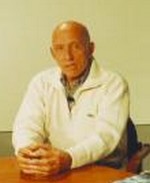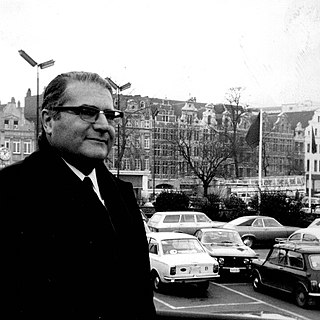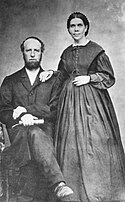Paul Claude Marie Touvier was a French Nazi collaborator during World War II in Occupied France. In 1994, he became the first Frenchman ever convicted of crimes against humanity, for his participation in the Holocaust under Vichy France.

Countess Andrée Eugénie Adrienne de Jongh, called Dédée and Postman, was a member of the Belgian Resistance during the Second World War. She organised and led the Comet Line to assist Allied soldiers and airmen to escape from Nazi-occupied Belgium. The airmen were survivors of military airplanes shot down over Belgium or other European countries. Between August 1941 and December 1942, she escorted 118 people, including more than 80 airmen, from Belgium to neutral Spain from where they were transported to the United Kingdom. Arrested by the Nazis in January 1943, she was incarcerated for the remainder of World War II. After the war, she worked in leper hospitals in Africa.

Gabrielle Weidner was a Dutch resistance fighter playing an active role in the French Resistance during World War II.

Alfred-Felix Vaucher was an Italian theologian, church historian, and bibliographer. He was a pioneer in the history and study of Seventh-day Adventism.

Fresnes Prison is the second largest prison in France, located in the town of Fresnes, Val-de-Marne, south of Paris. It comprises a large men's prison of about 1200 cells, a smaller one for women and a penitentiary hospital.

Suzanne Spaak, néeAugustine Lorge known as Suzette Spaak was a World War II French Resistance operative. On 21 April 1985, Yad Vashem recognized Spaak as Righteous Among the Nations, for helping to smuggle several Jewish children to safety, by providing them with ration cards and clothing.

Jewish resistance under Nazi rule took various forms of organized underground activities conducted against German occupation regimes in Europe by Jews during World War II. According to historian Yehuda Bauer, Jewish resistance was defined as actions that were taken against all laws and actions acted by Germans. The term is particularly connected with the Holocaust and includes a multitude of different social responses by those oppressed, as well as both passive and armed resistance conducted by Jews themselves.

Leo Bretholz was a Holocaust survivor who, in 1942, escaped from a train heading for Auschwitz. He has also written a book on his experiences, titled Leap into Darkness.

Jacques Desoubrie was a double agent who worked for the Gestapo during the German occupation of France and Belgium during World War II. He infiltrated resistance groups, such as the Comet Line, and was responsible for the arrest of several leaders and more than 100 members of organizations helping Allied airmen who had been shot down or crash-landed to evade German capture and escape occupied Europe. After the war he was tried, convicted, and executed in France.

José Giovanni was the pseudonym of Joseph Damiani, a French writer and film-maker of Corsican origin who became a naturalized Swiss citizen in 1986.

Tina Strobos, née Tineke Buchter, was a Dutch physician and psychiatrist from Amsterdam, known for her resistance work during World War II. While a young medical student, she worked with her mother and grandmother to rescue more than 100 Jewish refugees as part of the Dutch resistance during the Nazi occupation of the Netherlands. Strobos provided her house as a hiding place for Jews on the run, using a secret attic compartment and warning bell system to keep them safe from sudden police raids. In addition, Strobos smuggled guns and radios for the resistance and forged passports to help refugees escape the country. Despite being arrested and interrogated nine times by the Gestapo, she never betrayed the whereabouts of a Jew.
Dutch-Paris escape line was a resistance network during World War II with ties to the Dutch, Belgian and French Resistance. Their main mission was to rescue people from the Nazis by hiding them or taking them to neutral countries. They also served as a clandestine courier service. In 1978 Yad Vashem recognized Dutch-Paris's illegal work of rescuing Jews by honoring the line's leader, Jean Weidner as Righteous Among the Nations on behalf of the entire network.

Edmond Debeaumarché was a French postal worker who joined the French Resistance during World War II. For his service Debeaumarché was highly decorated. In 1960 Debeaumarché received the posthumous distinction of being depicted on a postage stamp in the series Heroes of the Resistance.

Suzanne 'Touty' Hiltermann-Souloumiac, née Hiltermann, resisted the Nazis as part of the Dutch-Paris escape line during World War II. She survived Ravensbrück concentration camp. She received the US Medal of Freedom in recognition of her help to evading Allied airmen. After the war she wrote children's stories and founded a French school in Hong Kong.
Johan Herman Laatsman de Bailleul was a Dutch diplomat with a distinguished Resistance record during the Second World War. For his contributions to the Allied cause, particularly as a member of the Dutch-Paris Escape Line, Laatsman was named a Ridder van Orde de Oranje-Nassau, a Commandeur de la Legion d’Honneur, merite international pour courage et devouément, and awarded the US Medal of Freedom with Silver Palm. The citation for the Medal of Freedom mentions that he embarked on a “self-imposed mission with outstanding success” and enabled the escape of at least 112 Allied aviators.

Marie Elisabeth Jean Elmes was an Irish aid worker credited with saving the lives of at least 200 Jewish children at various times during the Holocaust, by hiding them in the boot of her car. In 2015, she became the first and only Irish person honoured as Righteous Among the Nations by the State of Israel, in recognition of her work in the Spanish Civil War and World War II.

Mathilde Adrienne Eugénie Verspyck "was a brave woman who was a devoted believer in the cause of freedom, for which she later sacrificed her life," according to her U.S. Medal of Freedom award.

Escape and evasion lines in World War II helped people escape European countries occupied by Nazi Germany. The focus of most escape lines in Western Europe was assisting British and American airmen shot down over occupied Europe to evade capture and escape to neutral Spain or Sweden from where they could return to the United Kingdom. A distinction is sometimes made between "escapers" and "evaders". Most of those helped by escape lines were evaders.
Max Windmüller was a German member of the Dutch resistance. He was forced to flee from the National Socialists to the Netherlands with his parents because of their Jewish faith. He joined the Westerweel Group there and saved the lives of many Jewish children and young people. The members of the Westerweel group organized identification papers, hiding places and escape opportunities, especially for German-Jewish children and young people who had fled from Germany. In this group, Jews and members of other faiths worked together to save the Jews from persecution. Such cooperation was not a matter of course in the Netherlands. Windmüller personally saved around 100 young Jews, and the entire Westerweel group saved 393 Jews. In July 1944, the Gestapo stormed a secret meeting of the Resistance group in Paris in which Windmüller and other members of the Jewish resistance were arrested. They were then taken to Gestapo headquarters where they were interrogated and tortured. When the liberation of the camp by Allied troops was imminent, Windmüller was deported from occupied France with the last transport. On 21 April 1945, he was shot by a Schutzstaffel member.

Edmond Solomon "Moen" Chait (1912-1975) was a resistance leader of the Dutch-Paris Escape Line during the Second World War. Himself a Jew, Chait began his resistance career by helping other Jews to hide in the city of Antwerp, Belgium, as a member of the illegal Comité de Défense des Juifs. In mid-1942 he relocated to the city of Lyon, France, where he volunteered to lead Jewish refugees to neutral Switzerland. A year later in 1943, that escape line over the Swiss border expanded to reach from the Netherlands to Spain and Switzerland, going through Brussels, Paris, Lyon and Toulouse. Chait acted as one of the three leaders of the line, along with Jean Weidner and Jacques Rens. Chait took on the most dangerous missions such as carrying large amounts of cash across borders or escorting Jewish children to safety. He also arranged the escapes of prominent Dutch resisters, civilians wanting to join the Allies in England and downed Allied aviators.


















